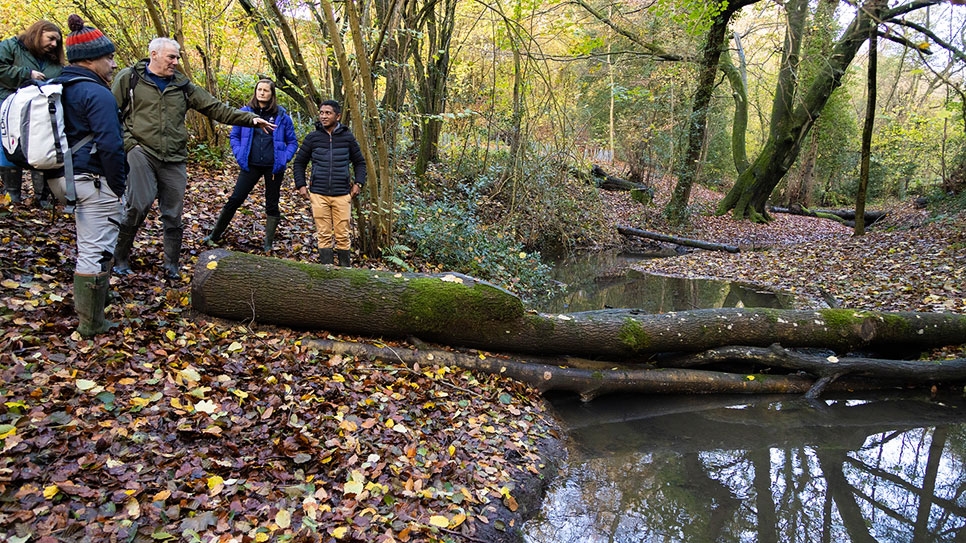WWT secures funding to help promote Natural Flood Management in the Thames Valley
Flood prone communities in the Thames River catchment as well as local wildlife are set to benefit from £1.5 million funding allocated from the Thames Regional Flood and Coastal Committee for natural flood management projects, facilitated by WWT expertise.

This project will bring innovative, natural techniques to help protect flood prone communities along the River Thames and its tributaries. Over the next two years, WWT will support local authority flood risk managers to access best practice in natural flood management. These measures are designed to work with nature to slow the flow and store more water in the landscape, thus reducing flood risks. Promoting a greater role for these sustainable, long-term solutions as part of the overall flood risk management strategy in the Thames catchment, will benefit people and communities, whilst also providing a real boost for nature.
As part of this project WWT will:
- Support Flood Risk Managers and other stakeholders in the Thames catchment, to develop more Natural Flood Management ‘NFM’ projects.
- Help develop local NFM projects in the Thames catchment, with the active involvement of community groups and environmental charities.
- Further develop and improve accessibility for a layered mapping tool, with key flood-related information that helps identify potential locations for NFM delivery.
- Share best practice through delivering workshops, webinars, site visits and a conference.
- Highlight the multiple benefits of NFM to wider stakeholders. These include: biodiversity gains, cleaner water, increased resilience to climate change and opportunities for local people to enhance their nature connection and boost their wellbeing.
With a strong track record in delivering collaborative nature-based solutions that reduce flood risk at both a local and catchment scale, WWT is ideally placed to lead this project. WWT is also a member of the Environment Agency’s National Flood and Coastal Erosion Risk Management Strategy Steering Group. So, WWT can channel best practice from similar projects around the country into the Thames catchment, as well as sharing back lessons learnt in this project.
Corrie Grafton, WWT Thames NFM Advisor said:
Time and again, I’ve seen the benefits of direct, natural flood prevention measures out in the landscape. So, I’m hugely excited that we have the opportunity to promote natural flood management at scale, by supporting Lead Local Flood Authority Flood Risk Managers across the Thames catchment. The overall aim is to help local authorities increase the number of natural flood management schemes they are delivering as part of their local flood prevention measures. These green interventions have so many benefits for people and wildlife. Levy funding is available to deliver these measures at a local level and I’d encourage anyone interested, including local community groups, to contact me to find out more.
How natural flood management works
When heavy rainfall quickly reaches fast-flowing streams and rivers, flooding incidents can all too often occur. But natural flood management measures such as installing woody, ‘leaky’ dams that hold back the water in smaller streams, digging pools that temporarily store heavy rainfall, restoring wooded river margins, allowing more natural meandering river channels and planting hedges across sloping agricultural land; all provide natural solutions to slow the flow of water.
These green landscape interventions delay and reduce the peak river flows, reducing flood risks downstream. Restoring pockets of wetland habitats in all these places where water is held on the land, can also bring a host of other benefits such as cleaner water, reduced impacts of drought, and it provides crucial wildlife habitats to boost biodiversity.
Natural flood management isn’t intended as a standalone alternative to hard engineering flood protection schemes, but it is an important and sustainable option in preventing flooding. This ‘green engineering’ can often be more cost-effective, particularly in rural areas.
The Thames Regional Flood and Coastal Committee (RFCC) was established by the Environment Agency under the Flood and Water Management Act 2010. It brings together members appointed by Lead Local Flood Authorities and independent members with relevant experience. https://www.gov.uk/government/groups/thames-region...
To contact Corrie Grafton, Thames Natural Flood Management Advisor, please email oli.etherington@wwt.org.uk.



